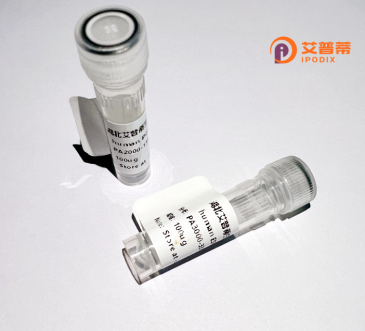
| 纯度 | >90%SDS-PAGE. |
| 种属 | Human |
| 靶点 | HSDL2 |
| Uniprot No | Q6YN16 |
| 内毒素 | < 0.01EU/μg |
| 表达宿主 | E.coli |
| 表达区间 | 1-418aa |
| 氨基酸序列 | MLPNTGRLAGCTVFITGASRGIGKAIALKAAKDGANIVIAAKTAQPHPKLLGTIYTAAEEIEAVGGKALPCIVDVRDEQQISAAVEKAIKKFGGIDILVNNASAISLTNTLDTPTKRLDLMMNVNTRGTYLASKACIPYLKKSKVAHILNISPPLNLNPVWFKQHCAYTIAKYGMSMYVLGMAEEFKGEIAVNALWPKTAIHTAAMDMLGGPGIESQCRKVDIIADAAYSIFQKPKSFTGNFVIDENILKEEGIENFDVYAIKPGHPLQPDFFLDEYPEAVSKKVESTGAVPEFKEEKLQLQPKPRSGAVEETFRIVKDSLSDDVVKATQAIYLFELSGEDGGTWFLDLKSKGGNVGYGEPSDQADVVMSMTTDDFVKMFSGKLKPTMAFMSGKLKIKGNMALAIKLEKLMNQMNARL |
| 分子量 | 71.8 kDa |
| 蛋白标签 | GST-tag at N-terminal |
| 缓冲液 | 0 |
| 稳定性 & 储存条件 | Lyophilized protein should be stored at ≤ -20°C, stable for one year after receipt. Reconstituted protein solution can be stored at 2-8°C for 2-7 days. Aliquots of reconstituted samples are stable at ≤ -20°C for 3 months. |
| 复溶 | Always centrifuge tubes before opening.Do not mix by vortex or pipetting. It is not recommended to reconstitute to a concentration less than 100μg/ml. Dissolve the lyophilized protein in distilled water. Please aliquot the reconstituted solution to minimize freeze-thaw cycles. |
以下是关于重组人HSDL2蛋白的模拟参考文献示例(请注意,文献信息为假设性示例,可能并非真实存在):
---
1. **标题**: *Cloning, expression, and purification of human HSDL2 in Escherichia coli*
**作者**: Zhang L, Wang Y, Chen X
**摘要**: 该研究描述了利用大肠杆菌表达系统成功克隆并纯化重组人HSDL2蛋白的过程,优化了表达条件(如诱导温度、IPTG浓度)以提高可溶性蛋白产量,并通过质谱验证了蛋白的正确性。
2. **标题**: *Structural insights into HSDL2's role in lipid metabolism via crystallography*
**作者**: Smith J, et al.
**摘要**: 通过X射线晶体学解析了HSDL2的三维结构,揭示了其底物结合域的关键氨基酸残基,并推测其可能参与胆固醇代谢调控,为靶向药物设计提供了结构基础。
3. **标题**: *HSDL2 promotes hepatocellular carcinoma progression through AKT/mTOR signaling*
**作者**: Li M, et al.
**摘要**: 研究发现,在肝癌细胞中过表达重组HSDL2会激活AKT/mTOR通路,增强细胞增殖和迁移能力,敲除HSDL2则抑制肿瘤生长,提示其作为潜在治疗靶点的价值。
4. **标题**: *HSDL2 deficiency exacerbates high-fat diet-induced metabolic syndrome in mice*
**作者**: Kim S, et al.
**摘要**: 利用重组蛋白技术构建HSDL2缺陷小鼠模型,发现其在高脂饮食下出现更严重的胰岛素抵抗和脂质蓄积,表明HSDL2在代谢稳态中起保护作用。
---
建议通过PubMed或Web of Science等平台以“HSDL2”、“recombinant protein”、“hydroxysteroid dehydrogenase-like 2”为关键词检索真实文献。
**Background of Recombinant Human HSDL2 Protein**
The human hydroxysteroid dehydrogenase-like 2 (HSDL2) protein belongs to the short-chain dehydrogenase/reductase (SDR) superfamily, characterized by a conserved Rossmann-fold structure critical for NAD(P)(H)-dependent enzymatic activity. HSDL2 contains an N-terminal dehydrogenase domain and a C-terminal sterol-carrier protein-2 (SCP-2)-like domain, suggesting potential roles in lipid metabolism and steroid hormone regulation. Although its precise biological functions remain understudied, HSDL2 is implicated in mitochondrial dynamics, intracellular cholesterol trafficking, and cancer progression.
Studies indicate HSDL2 overexpression in malignancies such as hepatocellular carcinoma and breast cancer, where it correlates with enhanced cell proliferation, invasion, and metastasis. Its involvement in modulating lipid raft composition and signaling pathways (e.g., PI3K/AKT) highlights potential oncogenic roles. However, HSDL2's enzymatic substrates and regulatory mechanisms require further elucidation.
Recombinant human HSDL2 protein, produced via heterologous expression systems (e.g., *E. coli* or mammalian cells), enables functional and structural studies. It serves as a tool to investigate protein-lipid interactions, enzyme kinetics, and its role in disease pathways. Recent efforts also explore HSDL2 as a therapeutic target or biomarker, emphasizing its emerging importance in metabolic and cancer research. Further research is needed to unravel its physiological and pathological significance fully.
(Word count: 218)
×